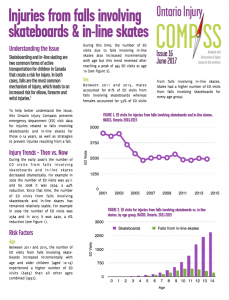Children are most likely to get hurt when they are just learning to skate, going too fast, skating near cars and traffic or not using safety gear.
Safety tips
- Recognize that injuries are particularly common in novice in-line skaters, roller hockey players and those performing tricks.
- Do not attempt tricks if you are inexperienced.
- “Truck-surfing”, sometimes called “skitching”, should be prohibited no matter what the level of experience.
- Carefully consider the type and fit of in-line skates when they are purchased. Ensure they are appropriate for the person’s size and ability.
- Have an experienced teacher provide instruction on appropriate reactions and proper stopping and falling techniques.
- Use dead-end streets or cul-de-sacs, streets that are blocked off to traffic or bicycle lanes or paths. Novice in-line skaters should practise first in a protected area before heading out to the street.
- People with large-muscle motor skill or balance problems, and those with any uncorrected hearing or vision deficit, should skate only in a protected environment such as a skating rink or outdoor skating area, where the in-line skater is either alone or away from motor vehicle or bicycle traffic and where all skaters and pedestrians travel in the same direction.
Protective equipment
- Properly fit all equipment to the child or adult.
- Ensure that equipment is certified by a recognized standards organization such as the CSA Group, the American National Standards Institute (ANSI) or, in the case of helmets, Snell or ASTM.
- Skaters performing tricks need heavy-duty protective wear.
Helmets
- Wear a properly fitted helmet to reduce the risk of serious head injury.
- Bike helmets or multi-sport helmets may be used for in-line skating. Be sure the multi-sport helmet shows clearly what activities it has been tested for.
Other protective equipment
- Wrist guards can help prevent broken bones and sprains of the wrist and arm by absorbing the shock and keeping the wrist from bending back during a fall. The most common injuries while in-line skating are broken bones.
- Elbow pads and knee pads may also protect from injuries, but there is little research to show that they are effective.
